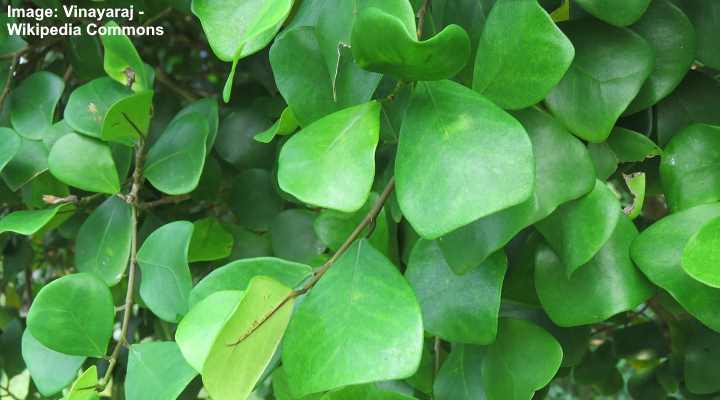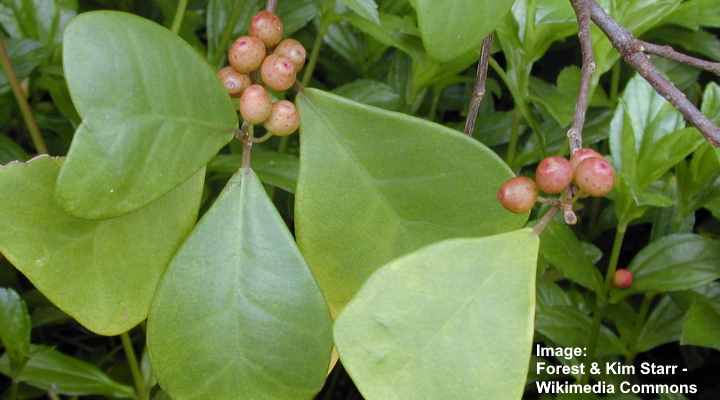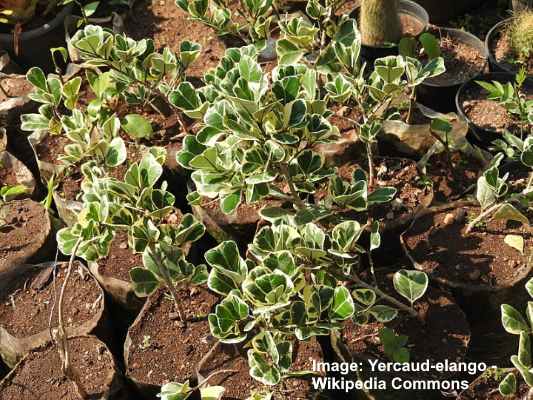Ficus Triangularis (Triangle Ficus): Care and Growing Guide

Ficus triangularis is one of the easiest ficus houseplants to grow indoors. Although ficus plants are notoriously fussy indoor plants, the ficus triangularis isn’t in this category. Also called the triangle ficus, the leafy plant gets its name from the leaves in the shape of a triangle. The truncate-shaped waxy leaves are a shiny dark green color and cover the woody plant’s stems. The ficus triangularis ‘Variegata’ has triangular-shaped green leaves with creamy-white margins and veins for a more dramatic appearance.
Ficus triangularis plants grow outdoors in USDA zones 12 and 13. This means that for most people, the triangle ficus is a tropical indoor plant that should grow in a sunny location. Despite its natural habitat being hot climates, ficus triangularis adapts well and thrives in the home environment.
This article is a complete care guide for the ficus triangularis. You will find out how to create the ideal environment for this tropical houseplant so that its green or variegated leaves thrive indoors.
About Ficus Triangularis

Ficus triangularis
The triangle ficus is a small flowering fig tree in the genus Ficus. The low-maintenance tree with its triangular leaves grows up to 8 ft. (2.4 m) high and 4 ft. (1.2 m) wide. The ficus plant has triangular-shaped leaves with a glossy shine.
Ficus triangularis produces small berry-like flowers in the form of a tiny fig (syconia). However, it’s rare—if ever—that a ficus triangularis houseplant blooms. However, the plant’s beautiful foliage of attractive triangle leaves makes up for the lack of any showy blooms.

Ficus triangularis inflorescence (syconia) looks like small berries
Even though ficus triangularis is classed as a small ficus tree, it won’t reach tree proportions when growing in a pot indoors. However, the pot’s size and occasional pruning will mean that the triangle ficus grows as a delightful tropical houseplant in your home.
How to Care For Ficus Triangularis
To care for a ficus triangularis houseplant, grow the leafy plant in bright light, protected from direct sunlight. A ficus triangularis thrives in well-draining fertile soil in temperatures above 55°F (13°C). Water the plant when the top layer of soil is dry and fertilize every four weeks to six weeks during the growing season.
About Ficus Triangularis ‘Variegata’ (Variegated Ficus Triangularis)

Ficus Triangularis ‘Variegata’
Ficus triangularis ‘Variegata’ is a popular plant due to its beautiful green and white triangular leaves and low maintenance.
The variegated plant has unique triangle-shaped leaves, and each one is different. The variegated leaves are shiny green and creamy white. Each leaf has yellowish-white irregular margins with green color in the center. Variegated ficus triangularis grows up to 4 ft. (1.2 m).
Ficus triangular ‘Variegata’ leaves are described as truncate shaped. This means that the triangular shape has a squared-off apex and narrow part at the stem (petiole). The abundant creamy-white markings around the leaf edges give the plant a bright appearance.
The triangular-shaped variegated leaves are all unique. On the same plant, leaves grow of varying sizes. Generally, the green and white leaves don’t grow larger than between 2” and 3” (5 – 7.5 cm) at the widest part.
How to Care For Ficus Triangularis ‘Variegata’
To care for a ficus triangularis ‘Variegata’, grow the tropical plant in indirect light to protect the variegation and prevent scorch. Plant in a well-drained, organically-rich potting mix. Only water when the soil partially dries. Apply a houseplant fertilizer every six weeks during the growing season. Room temperature and above-average humidity are ideal.
How to Grow a Ficus Triangularis Plant — Ficus Triangularis Care Guide
The ficus triangularis is an eye-catching bushy houseplant with unique leaves. The variegated ficus plant sits nicely on a desk, table, or shelf in a brightly lit room. Even though the plant isn’t as fussy as other ficus plants, some care is required to keep the leaves healthy.
Please read on to find out the best care tips to grow a ficus triangularis plant at home.
Where to Grow Ficus Triangularis Indoors
Ficus triangularis thrives in plenty of sunlight if protected from direct light. Indirect light will protect the waxy triangle leaves from sunburn. However, adequate sunlight is necessary to keep the plant happy and the foliage shiny and healthy. Ideally, a ficus plant needs eight hours of sunlight daily.
Although a ficus triangularis can withstand some shade, it generally requires consistent light for best growth. If there’s not enough light, try moving it to a bright spot in a south- or west-facing room. Alternatively, you could use artificial light to improve lighting conditions.
To keep the beautiful leaf variegation, a ficus triangularis ‘Variegata’ must get ample sunlight. The bright light helps to ensure that the creamy white patterns on the dark green leaves don’t fade. But suppose you notice that the variegated ficus plant foliage becomes greener. In that case, place the plant in a brighter spot.
Top tip for growing ficus triangularis: Rotate the plant every so often to ensure all the foliage gets the same amount of sunlight.
The Best Potting Soil for Growing Ficus Triangularis
Ficus triangularis thrives in an organically rich, well-drained potting mix. To create a suitable substrate for a ficus plant, mix equal parts of sphagnum peat moss, pine bark, and perlite. Alternatively, you can use a commercial potting soil amended with perlite to improve drainage and prevent root rot.
The soil mix should retain enough moisture yet drain well. For example, the combination of peat moss and perlite acts as a moisture retainer yet allows water to drain fast. That way, you avoid the growth issues that come with overly wet soil or a potting mix that dries out too fast.
How to Water a Ficus Triangularis Houseplant
The time to water a ficus triangularis is when the top layer of soil is dry. Water a ficus triangularis by drenching the soil with lukewarm water until it drains from the pot’s drainage holes. Wait until the top 1” to 2” (2.5 – 5 cm) of soil is dry before watering again.
A ficus plant requires regular watering in summer and less in winter. Typically, you will need to water a ficus triangularis about every seven to ten days. However, rather than having a watering schedule, check the soil for dryness. This way, you can prevent the soil from drying out or becoming waterlogged.
During the winter months, you can get by with occasional watering. However, always let the moisture levels in the soil determine when you should water the ficus triangularis.
Here are some handy tips for caring for a ficus triangularis:
- Allow water to sit in a jar for 24 hours before watering to allow any harmful chemicals to evaporate.
- Check that the water temperature is at room temperature to avoid watering ficus plants with cold water.
- Let the soil dry partially between watering sessions.
- Always plant a ficus triangularis in a pot with drainage holes
- Never let the ficus plant pot sit in a saucer of water; otherwise, you could cause root decay.
- If water starts to drain poorly, this could be due to compacted soil or the plant is root-bound.
Ficus Triangularis Temperature Range
A ficus triangularis performs well in average household temperatures. The best temperature for the plant is between 60°F and 75°F (15°C – 24°C). A ficus plant’s growth will slow in temperatures between 55°F and 60°F (13°C – 15°C). Don’t allow the plant to grow below 55°F (13°C).
Normal household temperatures are ideal for ficus triangularis. However, it’s a good idea to ensure the plant doesn’t suffer from sudden fluctuations in temperature.
For example, cold drafts from an open window on freezing winter days can kill a tropical plant. In addition, the cold airflow from an air conditioner unit can cause stress. Similarly, growing next to a hot furnace or radiator can cause the plant’s foliage to wilt.
How Much Humidity Does Ficus Triangularis Plant Need?
Ficus triangularis grows best in humid conditions, slightly higher than average household humidity. To increase humidity levels, you could place the pot on a pebble tray with water, use a room humidifier, or grow tropical plants together. However, a ficus plant will adapt to average home humidity if you water it properly.
Should you wipe the triangular ficus leaves with a damp cloth to boost humidity levels? A damp cloth will provide some moisture for the leathery foliage, which is probably insufficient if the household air is excessively dry. But wiping the leaves regularly is an excellent idea to keep them clean from dust and improve photosynthesis.
How to Fertilize Ficus Triangularis
A ficus triangularis plant benefits from a balanced all-purpose fertilizer. A diluted houseplant fertilizer provides the nutrients required for a variegated ficus plant. You can also use an organic fertilizer like fish emulsion, compost tea, worm tea, or kelp. Apply diluted fertilizer from late March until September, and don’t fertilize during winter.
Ficus Triangularis Growth Rate
A small fig tree with triangular leaves has relatively slow to moderate growth. You can ensure optimal growth conditions by putting the ficus plant in bright sunlight, watering when the soil partially dries and keeping the air humid.
Factors that can negatively impact a ficus triangularis growth include:
- Becoming rootbound
- Seasonal changes as growth become dormant in winter
- Pest or disease issues
Pruning Ficus Triangularis for Healthy Growth
Generally, a ficus triangularis doesn’t require pruning. However, trimming leggy stems is an excellent way to keep a ficus triangularis looking neat and encourage bushy growth. In addition, you can trim off straggling growth in spring by snipping stems just above leaf nodes.
Pruning the small tropical fig tree is also a way to get stem cuttings and leaf cuttings for propagation.
Top tip when pruning ficus triangularis: Wear protective gloves to protect your skin from the plant’s irritating milky sap.
How to Propagate a Ficus Triangularis Plant
Ficus triangularis propagation is relatively straightforward. The easiest way to grow a new fig tree is to take a few healthy stem cuttings that are 3” to 4” (7.5 – 10 cm) long. Then, remove the lower leaves from the cuttings.
Next, place the ends of the woody stems in a well-draining moist potting mix. Create a humidity dome by putting a plastic bag over the pot and sealing it tight with an elastic band. During the propagation process, mist the soil every few days to keep it moist.
It takes three to four weeks for a ficus cutting to root. During this time, it’s vital to keep the cutting moist. Once roots appear, you can repot the newly-growing ficus tree in a larger pot.
How to Repot Ficus Triangularis
Signs you need to repot a ficus triangularis are roots poking out the pot’s drainage holes, water that drains slowly, or sluggish growth. Choose a container that is one or two sizes larger than its current one. Always repot with fresh well-draining soil that has a combination of peat moss and perlite.
During the repotting process, you can check the fibrous roots for signs of decay or rot. Then, trim them off as necessary.
If you plan to refresh the soil but use the same pot, you can cut the roots back by one-third. This way, you encourage healthy growth by giving the miniature tree room to grow. However, you limit its size and prevent the plant from becoming a tall indoor tree.
Pests Affecting Ficus Triangularis Growth
Houseplant pests such as spider mites, whitefly, and mealybugs can affect a ficus triangularis plant’s growth. You can eradicate plant bugs by using a neem oil spray. Combine 2 tsp. neem oil, 1 tsp. liquid dish soap, and 1 quart (1 l) of water in a spray bottle.
To treat your ficus tree for pests, spray the homemade insecticide liberally on all sides of the triangular leaves. Allow to dry. Repeat the natural insect treatment every seven days until all signs of the pesky insects have gone.
It’s vital to know how to spot the signs of a pest infestation to deal with it properly. For example, leaves turning a yellow color or a black sooty mold on foliage could indicate an issue with pests.
Here are some ways to identify harmful bugs on your ficus plant:
- Spider mites: You can recognize spider mites by the fine hair-like strands of web hanging from leaves. With a large spider mite infestation, you may notice webbing on leaves and stems.
- Whitefly: You will notice tiny white-colored flies when you disturb the waxy foliage, and they will start to fly away from the plant.
- Mealybugs: This type of scale insect looks like tiny bits of fluffy white cotton on stems and the undersides of leaves. Mealybugs also leave behind a cottonwool-like substance on foliage.
Related reading: How to treat spider mites naturally.
Diseases Affecting Ficus Triangularis Growth
Incorrectly watering a ficus triangularis plant or poor air circulation can lead to diseases like root rot, leaf spot, botrytis blight, and powdery mildew. Typical signs of ficus plant disease include leaves that turn yellow and then brown, or brown spots on leaves.
Suppose you notice discolored leaves. In that case, it’s vital to remove and destroy any infected foliage. Then, check the soil for dampness. If the soil seems soggy, it’s best to repot the plant in fresh potting soil. Then in the future, only water the ficus when the top layer of soil is dry.
Another way to help restore a ficus plant’s health is to ensure the growing conditions are ideal. Put the pot in a suitable spot with lots of bright light. If the foliage is too dense, then thinning out the leaves with some light pruning can also help to increase air circulation.
Caring for Ficus Triangularis — FAQs
Does ficus triangularis flower?
A ficus triangularis plant blooms under the right conditions. The plant produces flowers in spring and summer, and they resemble small fig-like berries in the form of syconia. The reddish berry-like flowers grow up to 0.8” (2 cm) in diameter. Unfortunately, ficus triangularis hardly ever flowers indoors.
How do you make ficus triangularis bushy?
Prune the stems just above a leaf node to encourage a ficus triangularis to develop bushy growth. New leaves will emerge from the stem. You can also remove some of the lower stems to create a small tree with thick green and white leaves.
You can also grow a variegated bonsai tree from a ficus triangular ‘Variegata’ plant with the appropriate pruning and training.
Why are the leaves on my ficus triangularis turning yellow and falling off?
Ficus triangularis leaves can turn yellow and drop if the plant is in a cold draft or near a hot radiator. Additionally, a lack of moisture or overwatering can result in yellow leaves. Other factors to check are a lack of bright light or bug damage on foliage.
Despite being reasonably robust, a ficus triangularis plant leaves can succumb to changes in the environment.
Is ficus triangularis toxic?
Plants in the Ficus genus have a milky-white poisonous sap that can cause irritation if it gets on the skin or ingested. So, it’s best to keep the tropical houseplant away from pets or children to prevent poisoning. Additionally, it’s a good idea to wear protective gloves when pruning the plant’s triangular leaves.
Related articles:
